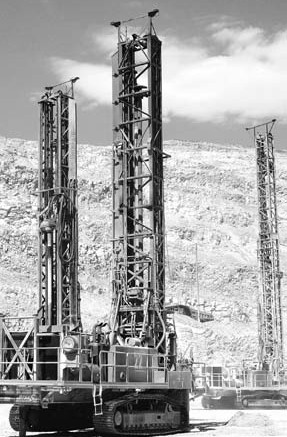Despite a 91% jump in oil prices, which averaged US$124 per barrel in the second quarter compared with US$65 per barrel in the same quarter a year ago, Barrick Gold’s (ABX-T, ABX-N) second-quarter revenues grew 20% year-on-year to US$2 billion while cash margins rose 68% to US$477 per oz.
Higher gold prices outpaced cash cost increases from surging energy prices and other inflationary pressures, allowing Barrick to post solid second-quarter results.
The Toronto-based gold major produced 1.86 million oz. gold at total cash costs of US$417 per oz. and realized a gold price of US$894 per oz. In the second quarter last year, Barrick produced 1.96 million oz. at total cash costs of US$340 per oz.
Net income of US$485 million (US56 per share) was an increase of 22% over the US$396 million (US46 per share) in the year-ago quarter. Operating cash flow of US$531 million (US61 per share) exceeded the US$336 million (US39 per share) from the year-ago quarter.
Barrick also produced 87 million lbs. copper during the quarter — less than previous years. Lower leach recoveries at Zaldivar, caused by acid shortages, and ore grade sequencing at the Osborne mine were responsible for the decline. Copper sales in the second quarter reached 78 million lbs. at total cash costs of US$1.08 per lb. and a realized price of US$3.65 per lb.
The company is maintaining its full-year guidance for copper of 380- 400 million lbs. at total cash costs of US$1.15-1.25 per lb. but expects production to be at the low end of the range.
Of its three most advanced projects in Tanzania, Nevada and the Dominican Republic, management expects its Buzwagi project in Tanzania will pour its first gold by the middle of next year. Buzwagi is forecast to churn out 250,000-260,000 oz. per year at estimated total cash costs of about US$300 per oz. based on a price tag of US$100 per barrel for oil.
Barrick anticipates it will receive the go-ahead to start building its advanced- stage Cortez Hills project in Nevada during the second half of the year. Cortez Hills is on schedule and within its capital budget of US$480-500 million, and more than half of the project’s funds have been committed or spent.
When Cortez Hills starts to operate, production is expected to increase to about 1 million oz. annually in the first full five years, at estimated total cash costs of about US$300 per oz. based on an oil price of US$100 per barrel.
In the Dominican Republic, meanwhile, work has begun at the Pueblo Viejo site. Long lead-time items such as mills, autoclaves, tanks, an oxygen plant and mining fleet have been secured. Construction will likely take about three and a half years.
At an oil price of US$100 per barrel, cash costs at Pueblo Viejo are estimated to be in the US$275-to US$300-per-oz. range for the first full five years of production. Barrick’s share of annual production during that timeframe is expected to be about 600,000 oz. gold.
In July, Barrick entered into a definitive agreement to sell certain non-core royalties to Royal Gold, (RGL-T, RGLD-Q) in exchange for US$150 million in cash and fewer royalties that Barrick has to pay to Royal Gold, including those for the Crossroads deposit, which is contiguous to Barrick’s Cortez mine in Nevada.
Overall, Barrick believes production will fall towards the lower end of its 7.6-to 8.1-million-oz. guidance this year due to lower mining rates at Bulyanhulu; lower ore grades at Plutonic; limited access to higher-grade ore at Cowal; and the impact of placing the Getchell mine on care and maintenance.
In Tanzania, Barrick’s joint-venture partner, Xstrata (XSRAF-O, XTA-L) expects to complete a prefeasibility study on the world-class Kabanga nickel sulphide deposit in the third quarter of 2008.
In Chile, work is under way to update a feasibility study at Cerro Casale. At Pascua-Lama, Barrick has yet to receive sectoral permits in Argentina and the resolution of certain fiscal matters, including the cross-border tax agreement.
Barrick also plans to increase its investment in an approved wind farm in Chile by US$30 million for a total cost of US$70 million.
In Papua New Guinea, work has started on the Kora target at the Kainantu property, as well as on the adjacent Wamun property, and on Tabar Island.
As of June 30, Barrick posted a cash balance of US$1.9 billion and net debt of US$2.1 billion after drawing from its credit facility to complete the Cortez cash transaction.
Cash costs for the remainder of 2008 are expected to be higher than originally thought due to energy costs, rising royalties and taxes based on higher gold prices, and higher costs for consumables.
Original guidance for total cash costs this year of US$390-415 per oz. gold was based on price assumptions of US$800 per oz. gold and US$90 per barrel oil. In the second half of the year, if the gold price reaches US$950 per oz. and the oil price is US$125 per barrel, the company expects total cash costs for the year to be in the US$425-to US$445-per-oz. range.
Of the difference between Barrick’s earlier and current guidance, about 30% is related to the impact of higher oil and energy costs; 15% to higher royalties and taxes; and 30% to increases in consumables and labour and the impact of currency movements.
In Toronto at presstime, the gold major traded at about $35.50 per share. The stock has traded in a 52- week window of $32.45-54.11.
Barrick’s market cap is $31.00 billion and the company has 871.8 million shares outstanding.


Be the first to comment on "Barrick’s Q2 strong despite rising costs"